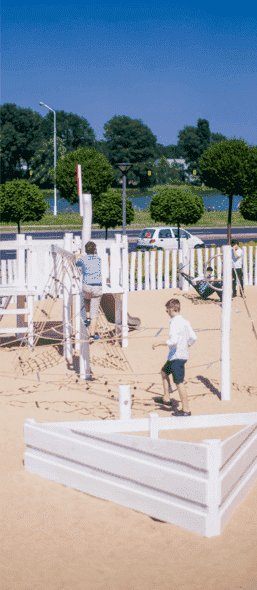
.
In this article, you will find practical tips to help you design a dog park. We will also discuss solutions and products that can streamline the design process, creating functional and friendly spaces in the heart of the city or its surroundings.
1. Safety first!
Safety should be a priority when designing a dog park! Choose fencing that is high enough to prevent dogs from escaping, but not overly imposing visually. Avoid sharp edges and elements that could pose a threat to the animals. It's also a good idea to install proper safety gates with locks that make it difficult for dogs to leave the park uncontrolled.
2. Variety of activity zonesThe dog park should offer a variety of activity zones tailored to different needs of dogs. It's worth investing in an agility equipment that supports the physical and mental development of the animals. For example, sets like Agility hoops or Agility slalom available on our website can be great additions. Various obstacles, bridges, tunnels, and seesaws will allow dogs to engage in different forms of activity, increasing the appeal of the park.
.
3. Paw-friendly surface
The surface is a key element of the dog park. It should be soft to minimize the risk of injuries, yet durable and easy to maintain. Natural surfaces like grass work well, as do specialized mats or rubber surfaces, which you can find in our range of products.
4. Common areas for the owners
Remember that the dog park is not only a place for dogs but also for their owners. Therefore, it's important to provide comfortable benches or shelters. Creating areas for rest and observation will make it easier for owners to spend time at the park. You might also consider adding informational boards that provide details about the rules of the park and upcoming events.
.
5. Socialisation and integration
Your dog park should encourage socialization for both dogs and their owners. It's a good idea to divide the park into sections—one for small dogs and another for large dogs, which will enhance comfort and safety. Zones designated for quiet walks as well as for more intense play will help meet the needs of different dogs. Equally important is providing enough space to avoid overcrowding, which can lead to conflicts between animals.
6. Easy Access and Location
The location of the dog park should be convenient for both residents and visitors. It's worth placing the park in an area with easy access to parking and near popular walking routes. A well-located park will attract more users and ensure safety.
7. Aesthetics and Attention to Detail
While functionality is crucial, don't forget about aesthetics. The dog park should be visually appealing and harmonized with its surroundings. Choosing high-quality materials and paying attention to details, such as diverse vegetation or decorative small architectural elements, will help create a space that is enjoyable for both dogs and people.
8. Maintaining tidiness and order in the Park
In a well-designed dog park, it’s essential to include waste bins. Dog waste bins and general trash bins should be strategically placed throughout the park to make it easier for owners to keep the area tidy. It's also important for dog owners to take responsibility by regularly cleaning up after their pets, which will help maintain hygiene in the park.
When creating a dog park, remember it’s a place meant to serve both animals and their owners. A well-designed park meets the needs of both groups, providing safety, entertainment, and comfort. If you're looking for inspiration and high-quality equipment, we encourage you to explore our offer, where you'll find a variety of agility elements and other accessories that will make your dog park truly exceptional.



















